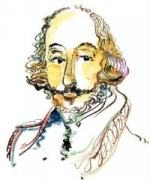|
This section contains 6,184 words (approx. 21 pages at 300 words per page) |

|
SOURCE: "Kingship of the Silent King: A Study of Shakespeare's Bolingbroke," in English Studies, Vol. 61, No. 1, February, 1980, pp. 24-36.
In the following essay, Baines argues that, despite what many critics have previously argued, Shakespeare portrays Bolingbroke in a sympathetic manner and that this depiction of the future king highlights Shakespeare's "very realistic" attitude toward kingship.
Few, if any, characters in the Shakespeare canon evoke such diverse and strong emotional response as the key figures of the second tetralogy: Richard II, Bolingbroke, and Hal. They are of course fascinating psychological portraits, but their special appeal derives from the political and moral issues which they dramatize. Together they present Shakespeare's courageous exploration of the controversial subject, kingship: the right to reign, the use and abuse of power, and the reciprocal responsibility of sovereign and subject. In these three kings whose fortunes and identities are inextricably linked, the playwright dramatizes the...
|
This section contains 6,184 words (approx. 21 pages at 300 words per page) |

|


